Southern California has a lot to offer visitors. Not only are there wonderful cities like Los Angeles, Costa Mesa, and San Diego, but there are also hundreds of lakes. In the entire state of California, there are more than 3,000 lakes. Most lakes are artificial because of the severe droughts and heat California deals with yearly. Some of these lakes are impressively massive! Here’s an overview in pictures:

Ready to find out more about the 12 biggest lakes in Southern California and what they have to offer?
1. Salton Sea

The Salton Sea is 43 feet deep and has a surface area of 343 square miles.
©bonandbon/Shutterstock.com
While the Salton Sea has the word ‘sea’ in it, this does not mean it is an ocean. Actually, the Salton Sea is a highly saline shallow lake in Southern California. It is 43 feet deep and has a surface area of 219,520 acres. This large lake is 236 feet below sea level. With how impressive it looks, it’s a surprise that the Salton Sea is man-made. It was created accidentally when the state diverted water from the Colorado River. The water is 30% saltier than the Atlantic Ocean, and salt is left behind when the water evaporates.
2. Mono Lake
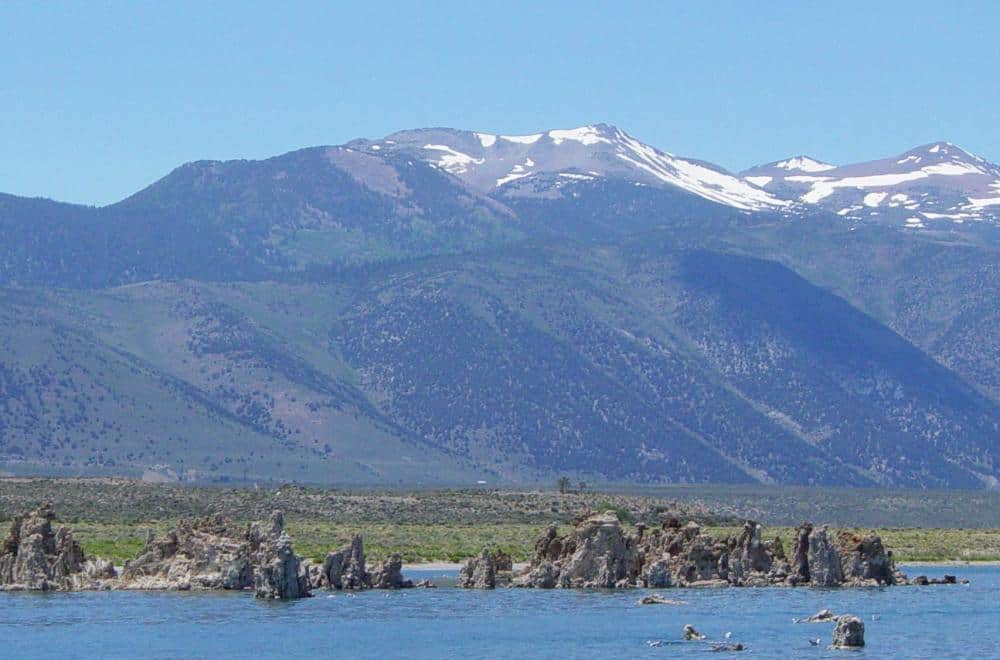
Mono Lake is a closed lake without an outlet.
©Mav / Creative Commons – License
Mono Lake is at least 760,000 years old and extremely salty. It is 13 miles long and 9.3 miles wide, with a surface area of 45,133 acres. Within the large lake are two main islands, Negit Island and Paoha Island. Mono Lake is a closed lake without an outlet. The water that leaves and enters is through weather (rain or snow) and evaporation. Fun fact, there are no fish in this lake because of the salt levels and alkalinity. However, there is a native species of shrimp, the Mono Lake brine shrimp, that birds feast on.
3. Clear Lake
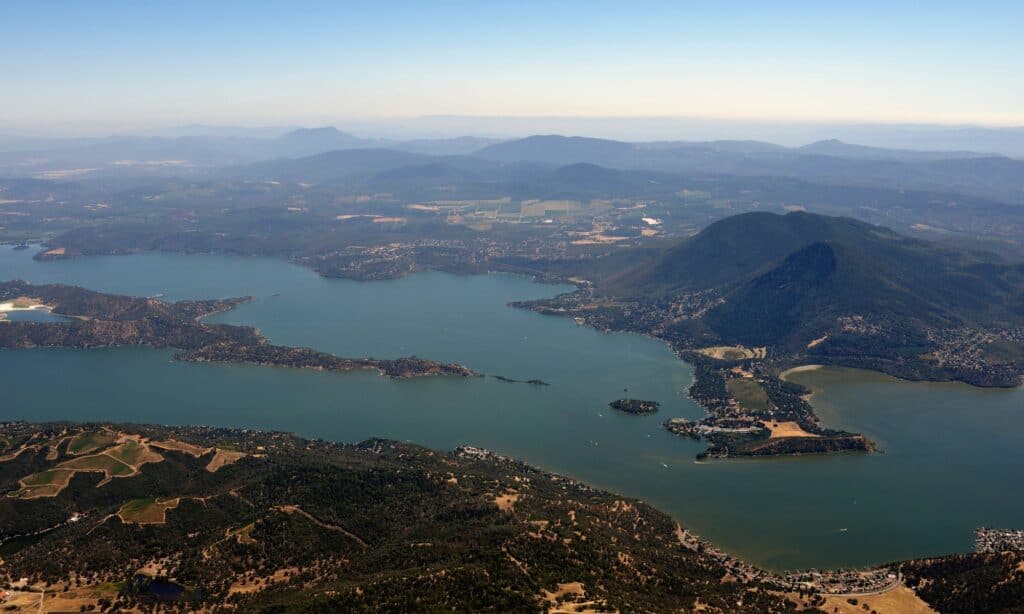
The average depth of Clear Lake is 27 feet.
©iStock.com/DigitalFilmWorks
Tourists and locals frequently visit Clear Lake for its beauty. It is a large lake in Lake County, California. It has a surface area of 43,520 acres and is 19 miles long and 8 miles wide. Most people visit Clear Lake to fish, birdwatch, and hike through the numerous trails. The average depth of this large lake is 27 feet, while the maximum is 60 feet. There are 100 miles of shore that you can use to fish. Fun fact, 2/3 of the fish caught in Clear Lake are largemouth bass. It is also an old lake rich in wildlife and fauna. Scientists estimate that this big lake is at least 480,000 years old. It’s possible to spot bald eagles, mountain lions, bears, deer, and blue herons here.
4. Lake Havasu
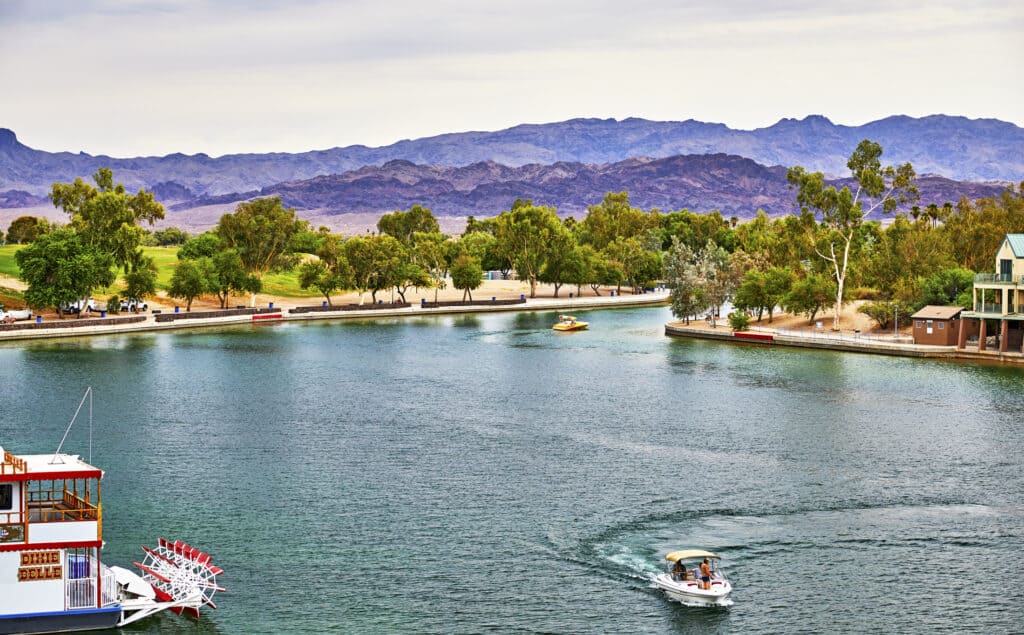
The average depth of Lake Havasu is 35 feet, while the maximum is 92 feet.
©iStock.com/wingedwolf
Fourth on this list is Lake Havasu, not to be confused with the community on the lake, Lake Havasu city. It is on the border between Arizona and California and was formed by the Parker Dam on the Colorado River. It is 26.3 miles long and 2.85 miles wide. The surface area is 19,300 acres. The average depth of the lake is 35 feet, while the maximum is 92 feet. At least 750,000 visitors come to Lake Havasu for its boating and fishing activities. In the water, you can fish for striped bass, crappies, sunfish, catfish, and largemouth bass.
5. Lake Isabella
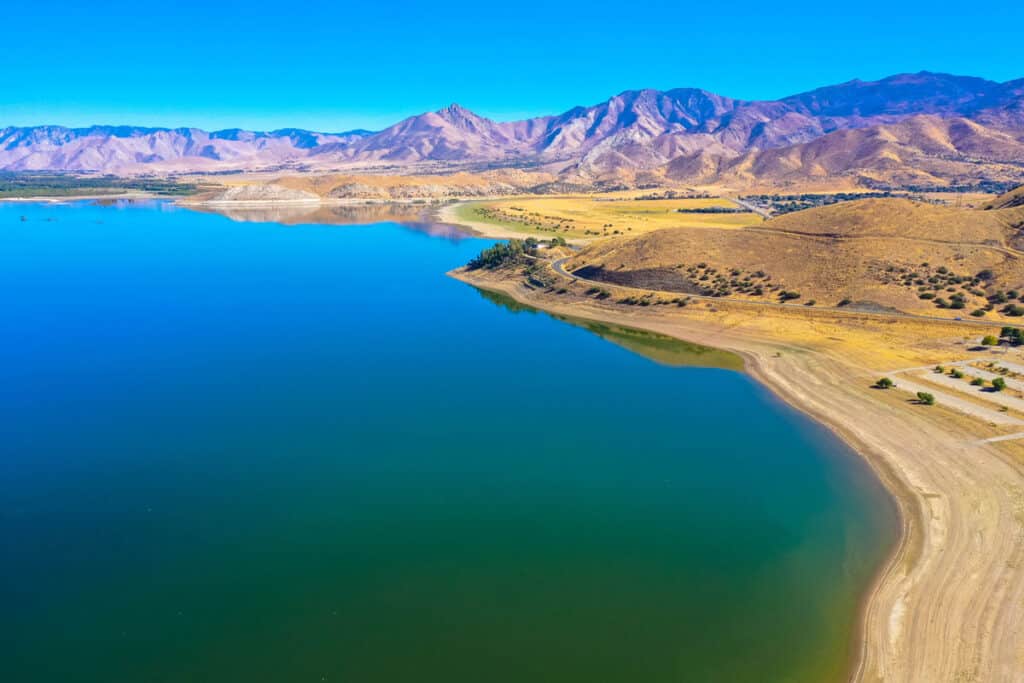
Lake Isabella is near Los Angeles and was formed in 1953.
©iStock.com/Eisenlohr
Lake Isabella is close to Los Angeles and is absolutely stunning. This lake was formed in 1953 by the earthen Isabella Dam when the U.S. dammed the Kern River. It is within the mountains at an elevation of 2,500 feet. The surface area of the lake is 11,000 acres, while the total average water volume is 568,000 acre-feet. There is something to do for everyone at Lake Isabella, especially since a large part is surrounded by the Sequoia National Forest. You can enjoy the glacial carved landscape, vibrant plants and wildlife, and fish in multiple lakes.
6. Lake Nacimiento

Lake Nacimiento is 18 miles long with a surface area of 5,400 acres.
©iStock.com/Ted Fletcher
Lake Nacimiento is considered Southern California by some, but it is closer to the center of the state. It is a large reservoir with multiple arms that branch out. Lake Nacimiento is 18 miles long with a surface area of 5,400 acres and a water volume of 377,000 acre-ft. It was originally made as a flood-control dam and reservoir but now acts as a popular entertainment lake. There is a limited number of fish in the water, though, because of high levels of mercury, meaning it is not ideal for fishing. Jet skiing and kayaking are common activities on the water. You can also camp and view wildlife in Lake Nacimiento.
7. Diamond Valley Lake
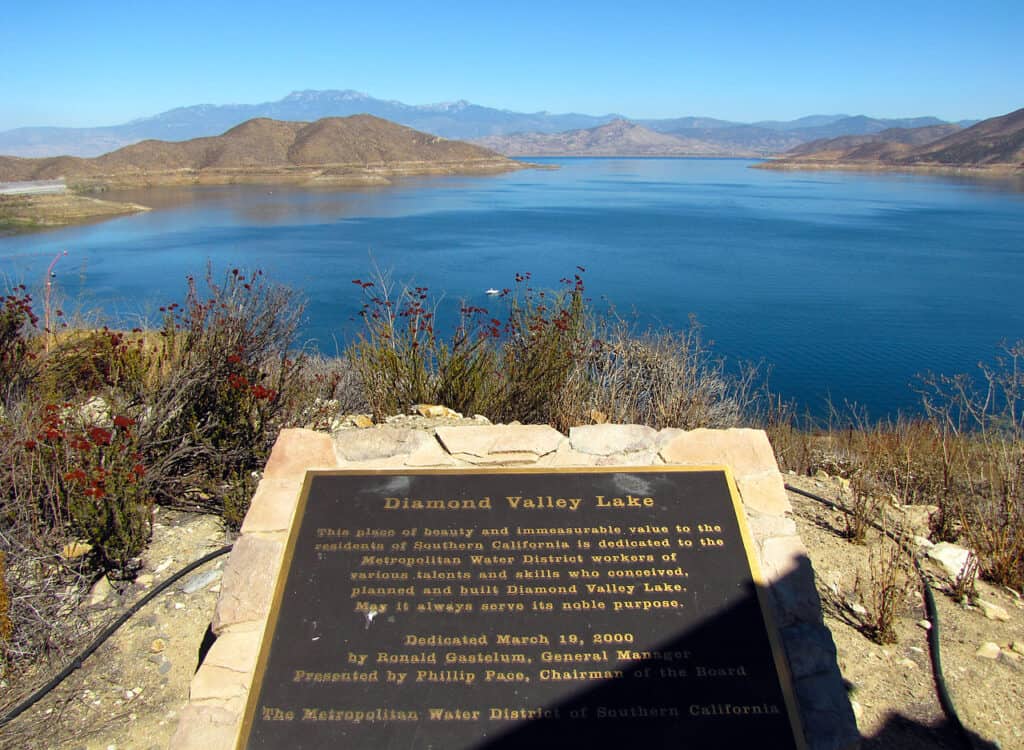
Diamond Valley Lake is an artificial lake in Riverside County, California.
©Lvi56 / Creative Commons – License
Diamond Lake is an artificial lake in Riverside County, California. It is massive, about 4.5 miles long and 2 miles wide. The surface area is 4,500 acres, and the maximum depth of the lake is 260 feet. It is one of the newer lakes in Southern California and was only completed in 2003. When the state dammed the lake, the workers found multiple paleontological finds, which are now displayed at the Western Science Center at the lake’s east end. Not only is this beautiful lake big, but it is situated between the Domenigoni Mountains and Rawson Mountains, making it perfect for hiking activities.
8. Cachuma Lake

Cachuma Lake is in the Santa Ynez Valley in the Los Padres National Forest.
©iStock.com/Paul Keague
Cachuma Lake is in the Santa Ynez Valley on the Santa Ynez River. In 1953, the U.S. Bureau of Reclamation constructed the Bradbury Dam, which formed Cachuma Lake. It is in the Los Padres National Forest and requires a quick hike through a trail to reach. Swimming and waterskiing are not allowed on this lake since it is used as clean and refreshing drinking water, but you can kayak and canoe. This lake has a surface area of 3,100 acres and a water volume of 205,000 acre-ft. While you can’t swim in the lake, you can camp in a tent, cabin, or with an R.V.
9. Lake Elsinore
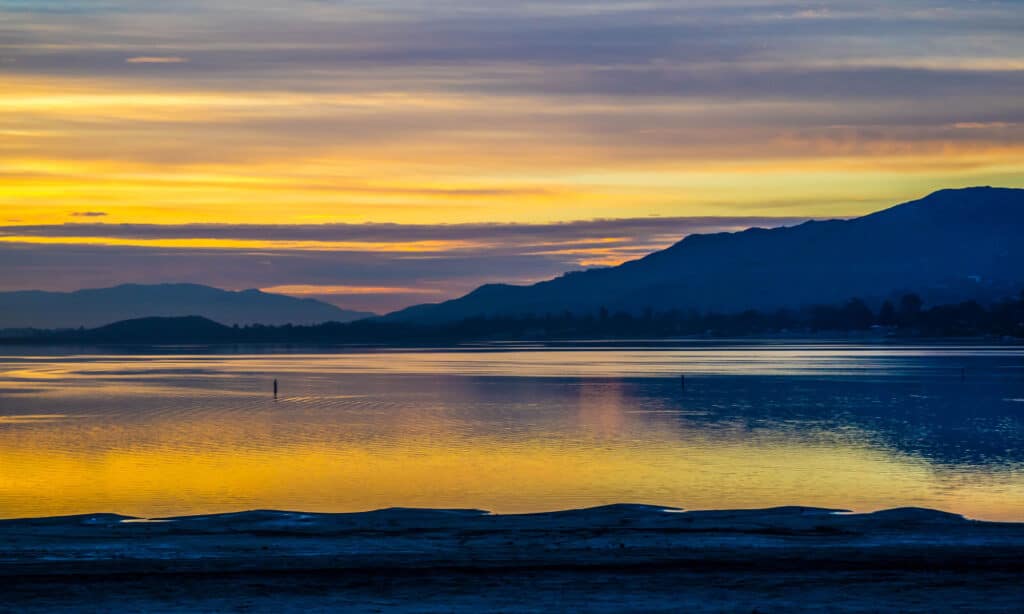
Lake Elsinore is 1.5 miles wide, with a surface area of 2,993 acres.
©iStock.com/Cavan Images
In Riverside County, California, you can find Lake Elsinore. It is a 6 mile-long natural freshwater lake and sag pond. It is 1.5 miles wide, with a surface area of 2,993 acres. Lake Elsinore is not a deep lake, as the maximum is only 42 feet. There are 14 miles of shore to enjoy fishing, sightseeing, and birdwatching activities. Lake Elsinore is home to a healthy population of blue catfish, rainbow trout, and redear sunfish. When you are tired of fishing, you can also take a dip in this large, refreshing lake.
10. Big Bear Lake
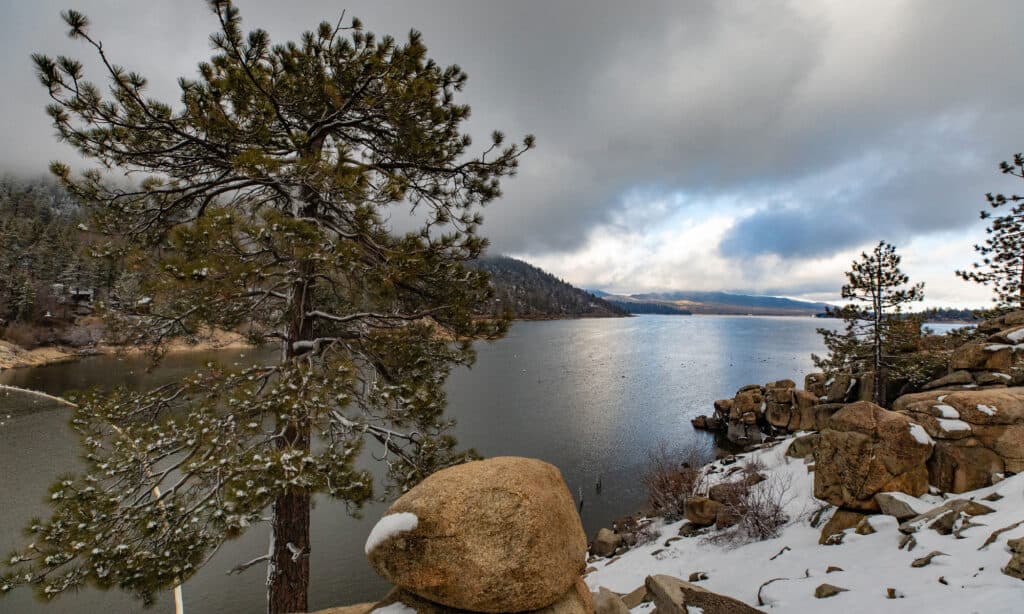
The surface area of Big Bear Lake is about 2,971 acres.
©iStock.com/Rcview_cinematography
Big Bear Lake is a big lake in Big Bear Lake city. It is 7 miles long and 2.5 miles wide. The surface area of the lake is about 2,971 acres with a water volume of 73,320 acre-ft. Big Bear Lake has a rich history and was first settled by the indigenous Serrano Indian tribe approximately 2,500 years ago. Grizzly bears are common near the lake and in the mountains, as they eat berries and hunt for fish. The climate is calm and cool, rarely going above 70 degrees Fahrenheit. Most people don’t swim because of how cold the water is, but you can still fish, boat, and kayak.
11. Perris Reservoir/Lake Perris

Lake Perris is a large lake in Riverside County, California.
©iStock.com/Angel La Canfora
Lake Perris, also known as the Perris Reservoir, is a large lake in Riverside County, California. It is home to the Ya’i Heki’ Regional Indian Museum, focusing on the indigenous Southern California people. The lake sits at an elevation of 1,595 feet, its maximum depth is 100 feet, and surface area is 2,347 acres. While fishing is allowed, there is a health advisory set warning people not to consume fish from the lake because of its high mercury content. Birdwatching is popular at Lake Perris. Over 100 bird species have been spotted in the area. Other animals that drink from this lake include bobcats, coyotes, and mule deer.
12. Castaic Lake

Castaic Lake is in the Sierra Pelona Mountains and has a large water volume of 320,000 acre-ft.
©iStock.com/David Diaz
Close to Los Angeles is Castaic Lake. This artificial lake is in the Sierra Pelona Mountains and has a surface area of 2,232 acres and large water volume of 320,000 acre-ft. It sits in Castaic Lake State Recreation Area, a state park near the Angeles National Forest. Its beauty and size attracted movie and T.V. producers. Fun fact, many episodes and fight scenes for the “Mighty Morphin Power Rangers” series were filmed at the lake. You can swim at the beaches and kayak for a small fee.
Summary of the 12 Biggest Lakes in Southern California
| Rank | Lake | Surface Area |
|---|---|---|
| 1 | Salton Sea | 219,520 acres |
| 2 | Mono Lake | 45,133 acres |
| 3 | Clear Lake | 43,520 acres |
| 4 | Lake Havasu | 19,300 acres |
| 5 | Lake Isabella | 11,000 acres |
| 6 | Lake Nacimiento | 5,400 acres |
| 7 | Diamond Valley Lake | 4,500 acres |
| 8 | Cachuma Lake | 3,100 acres |
| 9 | Lake Elsinore | 2,993 acres |
| 10 | Big Bear Lake | 2,971 acres |
| 11 | Perris Reservoir/Lake Perris | 2,348 acres |
| 12 | Castaic Lake | 2,232 acres |
The photo featured at the top of this post is © Pamela Au/Shutterstock.com
Thank you for reading! Have some feedback for us? Contact the AZ Animals editorial team.






